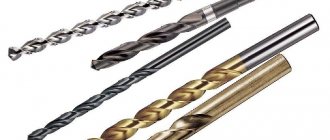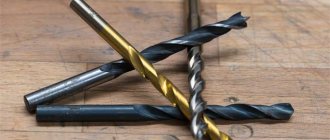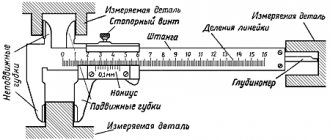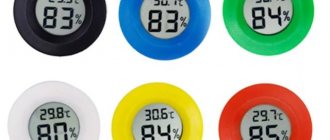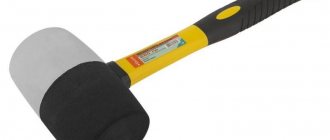The convenience and versatility of a step drill for metal facilitates work and increases productivity when drilling thin-walled metal workpieces from steel and non-ferrous metals up to 4-6 mm, replacing sets of twist drills for drilling different hole diameters.
It is a universal cone drill made from high-speed tool steel with the addition of cobalt or coated with titanium nitride, which enhances its strength.
They can be used not only for metal, but also for making holes in plastic, drywall, and wood. Can be installed on a screwdriver, drill or drilling machine.
Application area
Conical metal drills are used to make holes in sheet and thin-walled metal. Typically, the thickness of the metal being processed is from 1 to 4 millimeters and depends on the height of the drill step. If the height of the step is 4 millimeters, then the maximum thickness of the sheet or rolled metal that can be processed will be, respectively, 4 millimeters. A step drill allows you to work even with thin sheet metal.
The main difference from other types is that with the help of one drill you can get several standard sizes of holes at once.
Note that there are also conical drills for processing not only metal, but also wood, plastic, drywall, and textolite.
A conical drill (sometimes craftsmen call it a carrot drill) is also distinguished by the fact that when used correctly, the hole has virtually no defects. Proper use of the tool allows you to obtain smooth walls and edges of the hole, the absence of burrs and cracks. After drilling, there is no need for additional hole processing. Therefore, craftsmen often use them to correct defects in holes made with another type of drilling tool.
A high-quality metal cone drill bit has hard, sharp edges, which allows it to work with metal of high density and hardness. Some drills also have an abrasive coating, which further increases their effectiveness. Where another tool is powerless, it is often very convenient to use this type of drill.
The cone drill has a sharp tip, which allows the drilling operation to be carried out without preliminary core punching and additional centering.
Drilling materials
Any natural or artificial, that is, man-made, material in certain cases needs holes. When we say “natural materials” and “certain applications,” we mean medical drills (dentistry, surgery, etc.), oil and gas drilling, and other similar options. Well, there is no point in talking about the need for technological, technical, decorative and other holes due to their obviousness.
The most well-known drilling materials in everyday life are:
- tree;
- metals;
- stone (brick, concrete).
There are also special drills for working with ceramic and glass products.
There are special drills for working with ceramic and glass products.
Types of stepped (conical) drills
As noted, cone drills come with a smooth transition of diameter and with a step, stepped one. Step drills are most widely used, since they make it possible to obtain a hole of a strictly defined size with smooth walls. A hole made with a smooth tapered drill will always have a slight slope. In the case of working with thin sheet metal, this will be hardly noticeable.
In general, the quality of step drills can be classified by color:
- Metallic grey. Typically, such a tool is made of low quality tool steel. No additional heat treatment was provided during its manufacture either. There is no abrasive coating on the surface of the drill. Such drills should not be purchased if they are expected to be used regularly, as well as to work with thick and durable metal.
- Drills are black. Such a tool was subjected to heat treatment during production. Steam treatment and subsequent hardening were carried out. This treatment increases the hardness of the tool and increases its service life. But it is still not recommended to use such drills with stainless and other high-strength steels.
- Dull golden color. A step drill for metal, which has a pale yellow color, is made of metal with the addition of alloying additives, most often cobalt. Such a tool is subjected to hardening and subsequent tempering, which relieves internal stress and increases the strength and durability of the tool. Drills of this color can be used to process durable alloy and stainless steels.
- Bright golden hue. Tools of this color are the highest quality and are designed to work with thick-walled, high-strength steels. The steels from which the tools are made are obtained by adding titanium nitride and subsequent heat treatment.
Classification and features of the design plan
There are several varieties of such a tool. They differ from each other in functional and design features. It is also worth noting that with products designed for metal processing, you can drill other materials, which include:
- wood and materials made on its basis;
- different types of polymers;
- ceramics;
- concrete;
- brick.
The design of such devices is developed specifically to fully solve a number of technological problems, taking into account the properties of the material that will be processed. It is for this reason that experts advise before choosing to get at least the slightest idea about the features of this cutting tool.
So, drilling designs include the following components:
- The cutting element, which is responsible for the processing process itself.
- A tail that allows you to secure the tool in the equipment chuck.
- A working area that ensures the removal of remaining chips from the processing area.
Based on the nature of the design, it is customary to distinguish the following types of drills:
- spiral;
- flat;
- crowned;
- conical
Flat
Designs with a flat working part are sometimes called feather designs. Among the advantages of such products are:
- insensitivity to bevels;
- simple execution;
- cheapness.
The disadvantages include:
- inability to create large holes;
- lack of automated removal of sawdust from the working area (the geometric properties and design of this type of drill do not imply such a function).
Spiral
Spiral-type structures are considered the most common products used for processing metal products. The design of such drills is made in the form of a cylindrical rod, on the side of which there are spiral-shaped grooves. They are responsible for removing chips. Also, twist drills can belong to the following groups:
- General purpose products. The diameter of such an instrument reaches 80 millimeters. General purpose spiral products are used both in industry and in everyday life.
- Left-handed. It is impossible to do without such products in situations where you need to drill a broken fastener or bolt out of a hole.
- High precision drills. Such devices are used by real professionals or craftsmen who require excellent results from processing. These drills are usually designated "A 1". With their help you can make holes with precise diameters.
Crowned
The shape of core drills resembles a metal glass with cutting teeth located at the end. They are used for drilling holes in the material. The teeth can be made of some very hard metal alloy or have a special diamond coating.
This type of drill is designed for the annular drilling technique, in which only the contour of the future hole is selected.
Conical
Cone drills include devices with a stepped and smooth surface. Used to create holes in metal products, such products provide simple alignment at the beginning of the process, which cannot be said about cylindrical structures. But the most important advantage of cone drills is that they can be used to make holes of a wide variety of diameters.
Among the wide variety of drills, we can highlight products designed to create holes in high-strength materials, for example, cobalt drills.
These devices are made of high-speed steel alloy, which is alloyed with cobalt. It significantly increases the strength of the part. Due to these properties, cobalt tools are successfully used to create holes in high-strength materials. The high price of such products is entirely justified by their qualities.
Shape and dimensions
All cone drills for metal, as already mentioned, have a cone shape and can have a smooth or stepped diameter transition. The most widespread among mechanics is the step metal drill.
This is due to the fact that it is easier for them to work, since the transition from size to size when drilling is clearly visible, and achieving the desired diameter will not be difficult. The resulting hole has a fairly high surface quality and does not require additional finishing. And a fairly smooth transition from one step to another forms a chamfer for a pre-drilled hole.
Step drills differ in the number of steps, their height, diameter range and pitch. Typically, the diameter of the smallest drill step is 4 millimeters. The maximum size of the hole that a stepped tool can drill is up to 40 millimeters. The standard step height is 4 millimeters. This value determines what thickness of metal the tool can process.
The successive increase in diameter can be 2 or 3 millimeters. The standard step is 2 millimeters. Typically, if a cone drill has a wide range of diameter sizes (for example, from 4 to 40), then the step in this case can be 3 or 4 millimeters.
In specialized stores you can find step drills with a different range of diameters, so they should be selected for a specific set of tasks.
In addition to the working part of the drill, the tool also differs in the shape and size of the shank. The shank can have a cylindrical shape of various diameters, a hexagonal or triangular shape, as well as a specialized profile for specific connectors from hand tool manufacturers. A step drill for metal can be installed on a screwdriver, hammer drill or drilling machine.
Why is the drill called conical?
Drills are cutting tools that create a hole through translational and rotational action on the material at the point of contact. They are also often used for drilling or enlarging finished holes. In addition, they can be used to obtain non-through recesses. Depending on the shank, drills are cylindrical, hexagonal, triangular and conical. If you look in the dictionary, then a tool cone means nothing more than a conical shank, which means that this is a conical type drill. Its main convenience is quick change: in the event of a breakdown, you can always change the shank easily and quickly. The shank itself is made in the form of a nozzle, which is put on the working part.
In terms of their design, conical drills are not very different from ordinary standard drills, and they consist of the following elements: cutting and guide parts, shank, driver and neck. The main difference is the shape of the shank. In this case, it has the shape of a cone, which is what the name of these devices tells us. Depending on its shape, they are divided into even more specific types. The shank can be of the following types:
- Morse cone;
- metric;
- instrumental;
- elongated.
You should spend a few minutes briefly characterizing these types of attachments, which we will do below, and also consider other classifications.
Marking features
Step drills for metal may not always be marked. You should not look for markings on cheap Chinese tools or domestic drills of dubious manufacture. Such manufacturers can sometimes put on drills or their packaging only symbols that they understand, which do not characterize the tool in any way, but serve only for internal classification. But a high-quality professional tool from a trustworthy manufacturer always has a marking.
In the standard case, proper marking should contain in its designation all the main dimensions of the tool, material of manufacture, as well as characteristics of hardness or strength.
Let's take an example of the marking designation ø4-20/2 HSS4241-Co HRC 62.
This cone drill marking should be read as follows:
- ø4 – diameter of the first smallest stage of the tool (diameter of the smallest hole that can be obtained);
- ø20 – diameter of the last largest step of the tool (diameter of the largest hole that can be obtained);
- 2 – diameter pitch value (4-6-8-10-12-14-16-18-20);
- HSS 4241 – designation of the material from which the tool is made. HSS (High Speed Steel) – high-speed steel, 4241 – steel grade;
- Co – the material from which the tool is made contains cobalt, which gives it strength and durability;
- HRC 62 – Rockwell hardness value.
But most often, instead of marking, the manufacturer indicates on the packaging the main characteristics of a cone drill for metal. Moreover, the description of the characteristics is often accompanied by explanatory images to facilitate consumer understanding.
Taper shank drill - a modern take
Modern conical drills are made of durable carbon or alloy steel. Manufacturers often use additional heat treatment of the surface of these tools during manufacturing. This makes them more reliable and at the same time protects them from corrosion. The tapered shank design helps improve productivity and hole quality. Thanks to this shape (conical), the drill easily comes out of the material being processed.
As a rule, such drills are used to make various holes on a metal surface. They can also be used when holes are required on plastic, duroplastic or sheet steel (a conical stepped drill does an excellent job of this). The diameter of the shank or cone can range from 6 to 12 mm. And the cone length is possible from 58 to 85 mm. Drills are selected depending on the diameter and depth of the future hole.
Recently, craftsmen are increasingly using a spiral drill with a conical shank (GOST 10903-77) in their work. Usually he creates holes in various parts using stationary machines. The size of such drills can be from 5 to 80 mm. The tapered shank helps to significantly increase the surface area of contact between the drill bit and the head. This in turn helps not only to increase accuracy, but also to increase the reliability of fastening.
Today, twist drills can be long, solid carbide, special for processing light alloys, difficult-to-cut materials, and can also be additionally equipped with carbide inserts. This division of these tools allows you to more accurately select them for certain types of work. This will help improve not only the drilling process itself, but will also make the entire job better.
Advantages and disadvantages of these drills
In order to summarize the material presented and help you make a decision about the need to purchase a step drill, we will highlight the positive and negative aspects of this type of tool.
The advantages include the following characteristics:
- one stepped cone drill can replace a whole set of drilling tools (up to 16 ordinary drills);
- the resulting holes have a very high surface quality, which makes subsequent finishing processing unnecessary;
- ability to work with thin sheet steel;
- savings on purchasing a full set of drill sizes;
- cone drills have a short length compared to other types of drills, which simplifies the work;
- high-quality drills have high reliability and durability;
- the ability to drill at high speeds improves process productivity.
Among the disadvantages of step drills, we highlight the following features:
- Compared to other types of drilling tools, cone drills have a higher cost;
- when working with smooth conical drills, obtaining an exact diameter value is quite difficult even for a professional;
- to work with this type of tool you need to have certain skills;
- Sharpening stepped cone drills is quite difficult, especially at home.
Which step drills for metal are better - manufacturer's choice
An important criterion when purchasing a stepped nozzle is the manufacturer, since only products from trusted companies will have the required characteristics.
The market offers both domestically produced and imported attachments. Among the best Russian samples are the Zubr, Interskol and Tulamash step drills. All of these companies offer high-quality products, either individually or in sets, with a subsequent guarantee.
Among the imported manufacturers, we can note the companies Bosch, Haisser, Ruko Precision Tools.
How to choose the right step drill?
To choose the right step drill, you need to decide on the purposes for which the tool will be used. Thus, it is necessary to determine what size holes need to be drilled. The values of the smallest and largest diameters that are planned to be made are especially important.
You should also decide on what hand tool or machine the drill will be used. The type of shank that should be on the drill depends on this. Therefore, you should carefully study the drill chuck connector and clearly know the shape and dimensions of the shank. If the shank does not fit the existing connectors, you will have to separately purchase a special adapter.
It is important to decide on the manufacturer and level of the tool. As already noted, bright golden-colored stepped conical drills are made with cobalt and titanium impurities, with an abrasive coating and have high hardness. They will last longer and allow you to work with thick rolled products, stainless and alloy steels.
Look for the HSS designation on the label or packaging, which means the drill is made of high-speed steel. Try not to buy dubious Chinese-made drills.
Drills for ceramics and glass
Ceramic tiles or glass are drilled with a crown or a special spear-shaped tool. Its tip is made of either pobedite or tungsten carbide. If a specialized tool for glass or tiles is not available, you can use a concrete drill
It just needs to be sharp, and you need to work with it carefully, since its shape is not entirely suitable for such work.
Spear drill bit for ceramic tiles and diamond-coated bit.
A crown for glass and tile is almost no different from a crown for stone. Only on its cutting edge instead of teeth there is a diamond coating.
A tool called a ballerina is used to drill large holes in tiles. It resembles an ordinary compass. Drilling is done from the underside of the tile. The drill speed is set to minimum.
How to sharpen cone drills?
Cone drills are expensive, but at the same time quite reliable and durable cutting tools.
But in any case, after some time, their cutting edges become dull, and the tool loses its characteristics. Some step cone drills are designed to be sharpened, and some are not sharpened. Those that are not intended for sharpening are characterized by high quality cutting edges and durability. If the drill has a straight longitudinal groove, then sharpening can be done manually. If the groove is spiral-shaped, then sharpening should be done on a sharpening machine using an abrasive wheel. It is important to maintain the angle and dimensions of the cutting edge on each step drill diameter. The abrasive wheel used for sharpening must be fine-grained. If you have a similar drill at hand with non-blunted edges, you can take it as a template and focus on its dimensions and the profile of the cutting edge.
Self-sharpening
Drills, which are called stepped or conical, allow you to create holes with a diameter of 4 to 32 mm and are available in two versions: with the ability to sharpen or with a design that does not involve this technological operation. The high cost of products belonging to the second type is justified by their durability.
Their cutting edge (subject to all operating rules) does not become dull for a long time. It should be borne in mind that sharpening them without the appropriate experience can only lead to the fact that they become unsuitable for further use.
Cone drills of a certain configuration can be sharpened with a triangular abrasive rod
In order to properly sharpen a step drill, just watch the training video and follow the recommendations of qualified specialists. To perform this procedure, you don’t even have to rely on the drawing, but simply restore the original geometric parameters of the product.
Also, in some cases, it is permissible to use for these purposes thin abrasive diamond bars intended for sharpening knives, scissors and other tools.
Such a tool, like spiral drills with a conical shank, can be sharpened using a special machine equipped with an abrasive wheel, the working surface of which can be covered with ordinary sandpaper.
The geometric parameters of step drills, the guide grooves of which have a rectilinear shape, can be restored manually, and products with spiral grooves are best processed using a sharpening machine. It should be borne in mind that it is easiest to restore the geometric parameters of high-quality step drills.
Recommendations for use
When drilling large diameter holes, it is advisable to reduce the rotation speed as you approach the desired size. This is necessary in order not to switch to a larger diameter when chamfering with the conical section of the drill. In general, when working with stepped tools, you must adhere to the rule - the larger the diameter, the lower the speed.
Pay attention to the correct location of the part. The workpiece must be positioned in such a way that there is enough free space under it for the drill. It is necessary to use various backing plates to provide a solid and level base for drilling thin metal. When drilling, it is necessary to avoid overheating of the tool by using lubricants and cooling materials.
